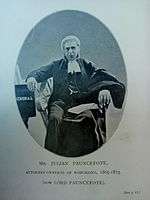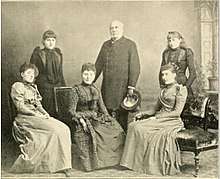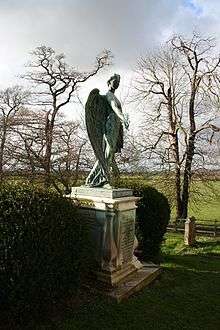Julian Pauncefote, 1st Baron Pauncefote
Julian Pauncefote, 1st Baron Pauncefote GCB GCMG PC (13 September 1828 – 24 May 1902), known as Sir Julian Pauncefote between 1874 and 1899, was a British barrister, judge and diplomat. He was Permanent Under-Secretary of State for Foreign Affairs between 1882 and 1889 when he was appointed Envoy Extraordinary and Minister Plenipotentiary to the United States, an office that was upgraded to that of Ambassador to the United States in 1893. Elevated to the peerage as Baron Pauncefote in 1899, he died in office in 1902.
The Lord Pauncefote GCB GCMG PC | |
|---|---|
 Caricature by Spy published in Vanity Fair in 1883. | |
| British Ambassador to the United States | |
| In office 1893 – 24 May 1902 | |
| Monarch | Queen Victoria Edward VII |
| Preceded by | New office |
| Succeeded by | Hon. Sir Michael Henry Herbert |
| Envoy Extraordinary and Minister Plenipotentiary to the United States | |
| In office 1889–1893 | |
| Monarch | Queen Victoria |
| Preceded by | Hon. Sir Lionel Sackville-West |
| Succeeded by | Upgraded to Ambassador to the United States |
| Personal details | |
| Born | 13 September 1828 Munich, Bavaria |
| Died | 24 May 1902 (aged 73) Washington D. C., United States |
| Nationality | British |
| Spouse(s) | Selina Cubitt |
Background and education
Pauncefote was born in Munich, Bavaria, the son of Robert Pauncefote and Emma, daughter of John Raphael Smith. His father had been born Robert Smith but had assumed the surname of Pauncefote in lieu of his patronymic in 1809. Robert Smith was the grandson of John Smith, brother of Sir George Smith, 1st Baronet (see Bromley baronets) and Abel Smith, ancestor of the Barons Carrington and the Barons Bicester.[1] He was educated at Paris, Geneva, and Marlborough College. Intending to join the British Indian Army, he obtained a commission in the Madras Light Cavalry, but never took up his post, instead being called to the bar in 1852.
Legal career
After qualification at the bar, Pauncefote practiced as a conveyancing barrister.
In July 1855, Pauncefote briefly became private secretary to Sir William Molesworth, Secretary of State for the Colonies at the time. His appointment lasted only short period ending with Molesworth's death in October that same year.

In 1862, facing crippling financial losses, Pauncefote decided to go and practise as a barrister in Hong Kong. In 1865, he was appointed acting Attorney General and in 1866 became the Attorney General of Hong Kong.[2] As attorney general, he served as acting Chief Justice and acting Puisne Judge on a number of occasions.[3]
In Hong Kong, Pauncefote was involved in a major case involving the rights of enslaved coolies to free themselves. He ended up being sued for false imprisonment in the Supreme Court of Hong Kong. In 1871, Kwok A Sing, a coolie on board a French ship the Nouvelle Penelope which had sailed from Macau, killed the master and took over the ship. Kwok was arrested in Hong Kong to be extradited to China. Kwok made a habeas corpus application seeking his release. Chief Justice John Jackson Smale ordered his release on the basis that Kwok was entitled to take any necessary steps to secure his freedom. Pauncefote, as Attorney General of Hong Kong, then had Kwok re-arrested to be tried for piracy. Smale again ordered Kwok's release on the basis the second arrest breached the first habeas corpus order. Kwok then sued Pauncefote for damages for false imprisonment under the Habeas Corpus Act. Kwok almost won with the British jury finding 4–3 in Kwok's favour. Because a majority of five was needed to find in Kwok's favour the verdict was treated as a verdict for Pauncefote.[4]
In 1874, Pauncefote was appointed Chief Justice of the Leeward Islands and knighted.
Diplomatic career
In 1876, Pauncefote returned to London as Assistant Permanent Under-Secretary of State for the Colonies. He soon transferred to the Foreign Office where he took over the same post at the Foreign Office in 1876.[1]
Having been made Knight Commander of the Order of St Michael and St George (KCMG) in 1879 and a Companion of the Order of the Bath (CB) the following year,[5] Pauncefote was promoted Permanent Under-Secretary of State for Foreign Affairs in 1882. He was appointed first British delegate to the Suez Canal Conference in Paris in 1885, and was rewarded for his services in this respect with appointment as a Knight Grand Cross of the Order of St Michael and St George (GCMG).[6] In 1888 he became a Knight Commander of the Order of the Bath (KCB),[7] and the following year was sent to the United States as Envoy Extraordinary and Minister Plenipotentiary.[8] His position was elevated in 1893 to Ambassador, and it made him the Dean of the Diplomatic Corps[9] because Ambassador is superior to all other Envoys dispatched by other countries. He and American secretary of state Richard Olney in January 1897 negotiated an arbitration treaty, but the U.S. Senate, jealous of its prerogatives. refused to ratify it.[10]
He was Britain's representative at negotiations and signatory of the Tripartite Convention in 1899 that partitioned the Samoan islands. In 1901 he negotiated the Hay–Pauncefote Treaty (with American Secretary of State John Hay), nullifying the Clayton–Bulwer Treaty of 1850, giving the United States the right to create and control a canal across Central America.
Having finally become a Knight Grand Cross of the Order of the Bath (GCB) in 1892,[11] Pauncefote the following year became the first British Ambassador to the United States. He was sworn of the Privy Council in 1894[12] and raised to the peerage as Baron Pauncefote, of Preston in the County of Gloucester, in 1899.[13]
Family

Lord Pauncefote married Selina Cubitt, daughter of William Cubitt, in 1859. They had one son, who died as an infant, and four daughters.
His youngest daughter, Hon. Lilian Pauncefote (1875–1963), married on 24 February 1900 her distant kinsman Sir Robert Bromley, 6th Baronet (1874–1906) (of the Bromley baronets). Bromley was honorary attaché to the British embassy in Washington, and the wedding at St. John's Episcopal Church in Washington was officiated by the Bishop of Washington, in the presence of cabinet members, diplomats and other distinguished guests.[14]
Death

Lord Pauncefote died in office at the British Embassy in Washington, D.C. in May 1902, aged 73. His formal state funeral took place at St. John's Episcopal Church in Washington, where his daughter had been married. His remains were transferred back to the United Kingdom in the USS Brooklyn,[15] and were buried at East Stoke near Newark-on-Trent on 15 July 1902.[16] The peerage became extinct at his death as he left no surviving male heirs.[1]
References
- thepeerage.com Julian Pauncefote, 1st and last Baron Pauncefote
- Review of Wright, Leigh, Julian Pauncefote and British Imperial Policy 1855-1889 on the freelibrary.com.
- Norton-Kyshe, the History of the Laws and Courts of Hong Kong, Vol II.
- Re Kwok A Sing (No.1) and Re Kwok A Sing (No.2) [2001] HKC 710 and 737. North China Herald, 28 December 1871, pp. 1003–4, for details of the case against Pauncefote.
- "No. 24837". The London Gazette. 23 April 1880. p. 2657.
- "No. 25535". The London Gazette. 1 December 1885. p. 5817.
- "No. 25823". The London Gazette. 2 June 1888. p. 3123.
- "No. 25917". The London Gazette. 2 April 1889. p. 1863.
- "Deans of the Diplomatic Corps". Bureau of Public Affairs, U.S. Department of State. 1 March 2013. Retrieved 24 September 2018.
- Nelson M. Blake, "The Olney-Pauncefote Treaty of 1897," American Historical Review, (1945) 50#2 pp. 228-243 in JSTOR
- "No. 26291". The London Gazette. 25 May 1892. p. 3137.
- "No. 26573". The London Gazette. 23 November 1894. p. 6625.
- "No. 27110". The London Gazette. 22 August 1899. p. 5249.
- "Court Circular". The Times (36075). London. 26 February 1900. p. 6.
- "The late Lord Pauncefote". The Times (36809). London. 2 July 1902. p. 1.
- "Funeral of lord Pauncefote". The Times (36821). London. 16 July 1902. p. 11.
| Legal offices | ||
|---|---|---|
| Preceded by John Jackson Smale |
Attorney General of Hong Kong 1866–1874 |
Succeeded by John Bramston |
| Preceded by None |
Chief Justice of the Leeward Islands 1874–1876 |
Succeeded by Henry James Burford Burford-Hancock |
| Government offices | ||
| Preceded by The Lord Tenterden |
Permanent Under-Secretary of State for Foreign Affairs 1882–1889 |
Succeeded by Sir Philip Currie |
| Diplomatic posts | ||
| Preceded by Hon. Sir Lionel Sackville-West |
Envoy Extraordinary and Minister Plenipotentiary to the United States 1889–1893 |
Raised to ambassador |
| New office | British Ambassador to the United States 1893–1902 |
Succeeded by Hon. Sir Michael Henry Herbert |
| Peerage of the United Kingdom | ||
| New creation | Baron Pauncefote 1899–1902 |
Extinct |